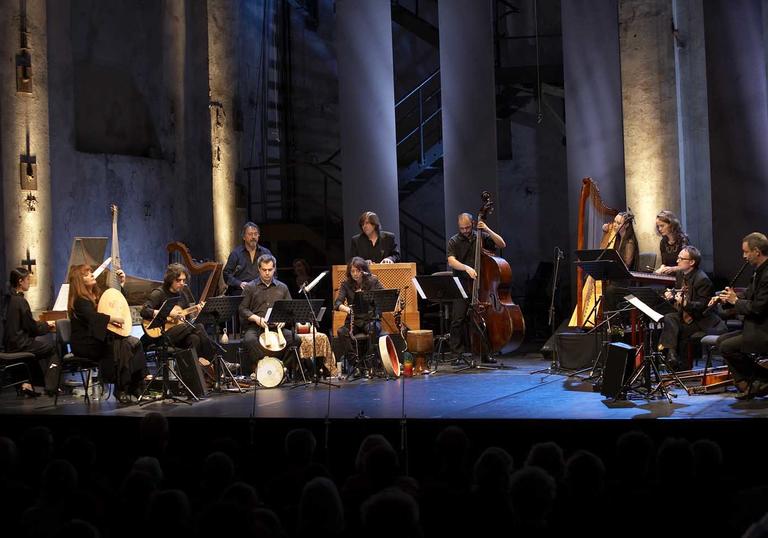
Programme and performers
Claudio Monteverdi Vespro della beata Vergine
1. Deus in adiutorium
2. Dixit Dominus
3. Nigra sum
4. Laudate pueri
5. Pulchra es
6. Laetatus sum
7. Duo Seraphim
8. Nisi Dominus
9. Audi coelum
10. Lauda Ierusalem
11. Sonata sopra Sancta Maria
12. Ave maris stella
13. Magnificat. Magnificat
14. Magnificat. Et exultavit
15. Magnificat. Quia respexit
16. Magnificat. Quia fecit mihi magna
17. Magnificat. Et misericordia eius
18. Magnificat. Fecit potentiam
19. Magnificat. Deposuit potentes de sede
20. Magnificat. Esurientes implevit bonis
21. Magnificat. Suscepit Israel
22. Magnificat. Sicut locutus est
23. Magnificat. Gloria patri et filio
24. Magnificat. Sicut erat in principio
Chorus
Céline Scheen soprano
Giuseppina Bridelli mezzo-soprano
Benedetta Mazzucato contralto
Vincenzo Capezzuto alto
Jan van Elsacker alto/tenor
Nicholas Mulroy tenor
Joshua Ellicott tenor
Dingle Yandell bass-baritone
Hubert Claessens bass-baritone
Greg Skidmore bass
L’Arpeggiata
Jorge Jimenez baroque violin
Jesus Merino Ruiz baroque violin
Anna Nowak baroque alto
Rodney Prada viola da gamba
Diana Vinagre baroque cello
Doron Sherwin cornetto
Gawain Glenton cornetto
Laura Agut trombone
Emily White trombone
Guy Morley trombone
Josep Maria Marti Duran theorbo
Daniel Espasa organ
Christina Pluhar artistic & musical direction
Translations
Deus in adiutorium meum intende.
Domine ad adiuvandum me festina.
Gloria Patri, et Filio,
et Spiritui Sancto.
Sicut erat in principio, et nunc et semper,
et in saecula saeculorum. Amen.
Alleluja.
O God, make speed to save me.
O Lord, make haste to help me.
Glory be to the Father and to the Son
and to the Holy Ghost.
As it was in the beginning, is now and ever shall be,
world without end. Amen.
Allelujah.
Artist biographies
Founded in 2000, L’Arpeggiata is an ensemble directed by Christina Pluhar. Its members are today’s finest soloists and in addition they work in collaboration with the most exceptional singers from the Baroque and the traditional music worlds.
The bases of L’Arpeggiata are instrumental improvisations, a different approach to singing centred on the development of vocal interpretation influenced by traditional music, and the creation and staging of attractive shows.
Since its foundation L’Arpeggiata has had an incredible response from the audience as well as from the critics: They have received outstanding reviews for their albums and concerts. Their album first album La Villanella dedicated to the music of Girolamo Kapsberger has been considered ‘Event of the month’ by Repertoire des disques in September 2001 and has been awarded with the Premio Internationale del disco per la musica italiana. Their second CD Homo fugit velut umbra devoted to Stefano Landi was ’10 de Repertoire’, ‘Diapason Découverte’, BBC's ‘CD of the Week’, ‘CD of the Month’ by Amadeus (Italy) and Prix Exellentia by Pizzicato (Luxemburg). La Tarantella, which proposes an encounter between baroque and traditional musicians, has been ’10 de Repertoire’, ‘CD of the Week’ by France Musique and ‘CD of the Month’ by Toccata (Germany). All’Improvviso, their third disc, was rewarded with 'Timbre de platine' of Opéra international, CD of the month by BBC Magazine, and their last CD, the Rapressentazione di Anima et di Corpo by Emilio de’ Cavalieri has won the prize of the academy 'Charles Cros'. Their album Los Impossibles (2010) stars the King’s Singers as well as the Flamenco guitarist Pepe Habichuela.
Their album Teatro d’amore (2009) included the singers Philippe Jaroussky and Nuria Rial and as well as their album Via crucis together the vocal ensemble from Corsica 'Barbara Furtuna’. In 2011 their version of the Vespro della beata vergine appeared on CD. Their album Los Pájaros perdidos (2012) is devoted to traditional and baroque music of Latin America and Mediterraneo (2013) included the Fado-singer Misia.
Winner in 2009, 2010 and 2011 of the Echo Klassik Preis in Germany, the Edison's price in Holland in 2009, the VSCD Musiekprijs in 2008, Arpeggiata has consistently been praised for its recording with rewards as the Cannes Classical Awards, Platinum of International Opera Magazine, CD of the Month of the BBC Magazine, amongst many others.
L’Arpeggiata has performed with great succes in festivals and concert halls around the world such in Lufthansa Festival London, Oude Muziek Utrecht, Festival de Pontoise, Printemps des Arts de Nantes, Theatre de Poissy, Theatre de Bordeaux, Rencontres de Vezelay, Festival Musique Sacree de Fribourg, Pfingstfestspiele Melk, Flagey à Bruxelles, Festival de St Michel-en-Thierache, Festival de Sablé-sur-Sarthe, Brugge Musica Antica, Musikverein Graz, Ludwigsburger Schlossfestspiele, Amsterdam Concertgebouw, Hong Kong Arts Festival, Sydney and in the Carnegie Hall in New York, among many others.
